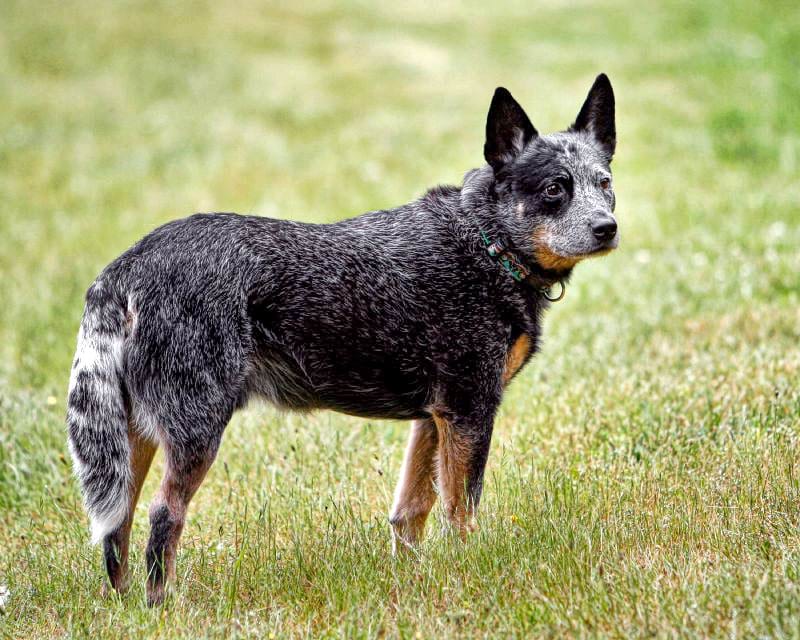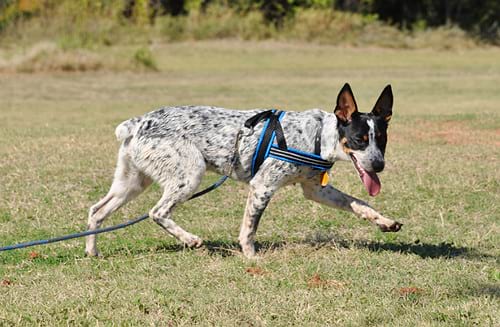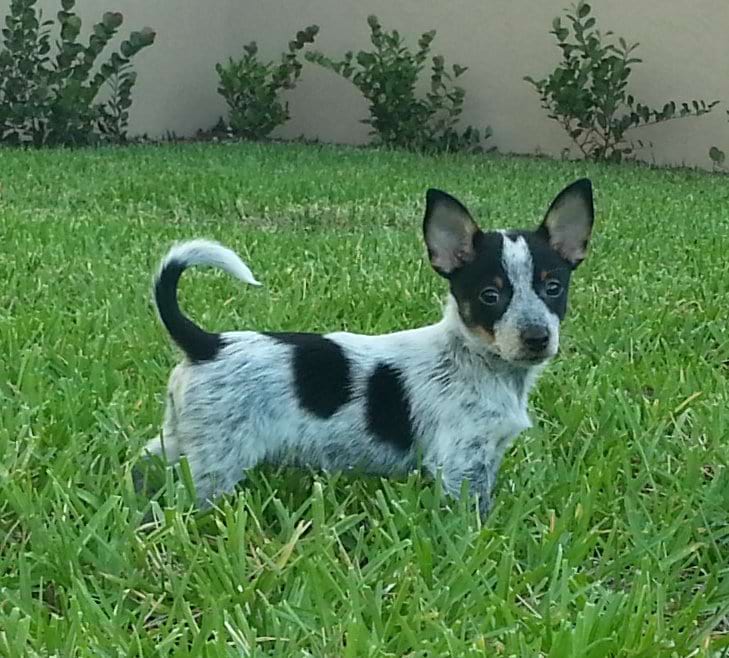The Blue Heeler Rat Terrier Mix, also known as a Rat Terrier or Blue Ratter, is a crossbreed between the Blue Heeler and the Rat Terrier. This breed is gaining popularity due to its unique and striking appearance and its loyal and energetic personality.
The Blue Heeler Rat Terrier Mix is known for its intelligence, agility, and high energy levels. It is an excellent choice for active owners looking for a dog to keep up with their busy lifestyle. However, owning a Blue Heeler Rat Terrier Mix requires significant time, attention, and training, as this breed can only handle it with proper care.
In this article, we will explore the characteristics and traits of the Blue Heeler Rat Terrier Mix to help you determine whether this breed is the right dog for you.
Blue Heeler Rat Terrier Mix: Breed Overview
| Other Names | Rat Terrier Cattle Dog Mix, Rat Terrier Blue Heeler Mix, Blue Heeler Rat Terrier, Rat Heeler, Queensland Heeler Rat Terrier Mix, ACD Rat Terrier Mix |
| Purity | Crossbred |
| Purpose | Companion/pest control |
| AKC Recognition | No |
| Size | Small-medium |
| Weight Range | 15-45 lbs |
| Height Range | 13-18 inches |
| Colors | Bicolor combinations of blue, red, tan, black, fawn, apricot, sable, silver, and chocolate with white |
| Child friendliness | High |
| Canine friendliness | Moderate |
| Training difficulty | Easy |
| Grooming needs | Easy |
| Exercise needs | Very high |
| Health | Excellent |
| Average Lifespan | 12-18 years |
| Average Puppy cost | $200-$700 |
What is a Blue Heeler Rat Terrier Mix?

A Blue Heeler Rat Terrier Mix is a hybrid dog breed resulting from the crossbreeding of a Blue Heeler (also known as the Australian Cattle Dog) and a Rat Terrier. This mix combines the intelligence, energy, and herding instincts of the Blue Heeler with the agility, alertness, and hunting prowess of the Rat Terrier.
Typically medium-sized, these dogs often exhibit a strong prey drive, making them excellent hunters and herders. Their coat can vary in color and pattern, reflecting the characteristics of both parent breeds.
Being highly energetic and intelligent, they require regular exercise and mental stimulation to prevent boredom and potential destructive behaviors. With proper training and socialization, the Blue Heeler Rat Terrier Mix can be a loyal, affectionate, and versatile companion suitable for active families.
Blue Heeler Rat Terrier Mix: Parent breeds
Intriguingly, this particular crossbreed has yet to establish an extensive lineage. Like many other so-called designer dogs, the precise point of origin remains shrouded in mystery, leaving one to wonder about the exact temporal origins of this fascinating breed.
Despite the opacity surrounding the Blue Heeler Rat Terrier mix, one can still glean vital information by examining the ancestral lineage of the respective parent breeds, delving into their provenance, and extracting insights on how this lineage may have influenced the resultant hybrid.
Origins and history of Blue Heeler

The origins of the Blue Heeler breed are steeped in a fascinating historical context, one that illuminates the breed’s provenance, purpose, and societal standing. This breed, also called the Australian Cattle Dog or Queensland Heeler, was first concocted by a group of brave Australian settlers in the 19th century who sought to develop a dog capable of herding cattle across long distances in inhospitable terrain.
The British Smithfields, imported from England, proved inadequate, excelling in sheep herding but failing miserably when tasked with cattle. Consequently, the Australian ranchers engaged in a flurry of breeding and crossbreeding, culminating in creating a rugged and resilient dog capable of withstanding extreme temperatures, hostile terrain, and the grueling work activities required for cattle herding.
In approximately 1840, Thomas Hall and George Elliott, dog lovers and experimenters par excellence, crossbred the British Smithfields with dingoes and Blue Merle Highland collies, resulting in a magnificent working dog with remarkable tenacity and strength. These dogs’ hard-working, gritty nature quickly caught the attention of Australian ranchers, who eagerly purchased the pups to assist them in their cattle herding endeavors.
The Bagust brothers, Jack and Harry, saw the potential for further improvement in these already impressive cattle dogs and sought to enhance their attributes by crossbreeding them with Dalmatians. They intended to infuse the dog with the loyalty and horse-friendly demeanor of the Dalmatians, resulting in a dog with the best of both worlds.
Finally, Mr. Kaleski created a standard for cattle dogs, which despite facing various objections, was eventually endorsed by the Cattle and Sheep Dog Club of Australia, and the original Kennel Club of New South Wales in 1903. This auspicious occasion marked a seminal moment in the breed’s history. The Australian Cattle Dog was ultimately approved for registration by the AKC on the 1st of May, 1980, and placed under the working group on the 1st of September, 1980.
Origins and history of Rat Terrier

The origin of the rat terrier, a dog breed named in honor of former US president Theodore Roosevelt, who allegedly used the dog to rid the White House of rat infestations, is a matter of ongoing debate. Nonetheless, it is widely accepted that the breed was initially developed as a vermin hunter on farms. To instill such a vital trait in the dog, American farmers began crossbreeding the fox terrier with the bull terrier, Manchester terrier, and old English white terrier.
Rat terriers’ popularity continued to grow. Between 1910 and 1930, American farmers saw the need to develop more robust strains with superior skills, resulting in new breed variations incorporating more unique and demanding songs. These more recent strains resulted from crossbreeding with whippets and Italian greyhounds, resulting in a more well-rounded and speedy dog with a more proficient working ability.
However, between 1930 and 1960, rat terrier popularity declined as farmers began incorporating pesticides to kill vermin. Nevertheless, a few breeders maintained this dog until it regained popularity in the late 1980s.
As the demand for smaller-sized dogs increased, breeders began crossing the rat terrier with the beagle, producing a compact dog with a strong sense of smell that could easily navigate smaller holes. This eventually led to the creation of toy or miniature rat terriers by breeding the rat terrier with toy fox terriers and toy Manchester terriers.
Around this time, two new variations of the rat terrier, the Decker Rat Terrier, and the Hairless Rat Terrier, were bred. The Decker rat terrier was bred to tackle small and prey hunting, from foxes and squirrels to cougars, wild pigs, deer, and even bears. On the other hand, the Hairless Rat Terrier is more miniature than the Decker RTs and is hairless, making it prone to sunburn, but they do not shed.
How Does a Blue Heeler Rat Terrier Mix Look Like?
The blue heeler-rat terrier mix can inherit a medium size from the blue heeler or a smaller stature from the rat terrier. Their fur might blend the black and white of blue heelers or showcase the varied hues of rat terriers.
Beyond size and coat, they may possess the captivating eyes of a blue heeler or the vibrant gaze of a rat terrier. Their build and facial structure also reflect their parentage. Ultimately, each mix showcases a distinct blend of these two breeds, resulting in a unique appearance.
Size, height, and weight
The Blue Heeler Rat Terrier mix inherits traits from both parent breeds. Blue Heelers stand between 17-20 inches and weigh 15-22 kg, while Rat Terriers are 10-13 inches tall, weighing 4-12 kg.
A typical mix might stand 13-17 inches and weigh 9-17 kg. However, individual sizes can vary. For a closer estimate, average the parents’ sizes, but remember it’s still a rough guide, as each puppy differs.
| Male | Female | |
| Size group | Small-medium | Small-medium |
| Weight | 15-45 pounds | 10-30 pounds |
| Height | 13-18 inches | 10-17 inches |
Coat colors and types
The Blue Heeler Rat Terrier Mix is a fascinating breed with various coat colors and types inherited from its parent breeds. These dogs have short, smooth coats that are easy to maintain and don’t require any trimming. However, if they inherit a double coat from their Blue Heeler parent, they may shed heavily during certain seasons.
One of the most striking features of the Blue Heeler Rat Terrier Mix is its coat color. They come in various colors: black, blue, chocolate, tan, fawn, silver, red, apricot, lemon, and sable. These colors may appear in patches, spots, or specks on a predominantly white coat, making them even more adorable and eye-catching.
Temperament and Personality

The Blue Heeler Rat Terrier Mix is known for its determined, energetic, and loyal temperament. This breed requires constant engagement, as they become destructive if left unstimulated. They may also exhibit wariness towards strangers but form strong bonds with their owners. The personality of the Blue Heeler Rat Terrier Mix may overlap significantly with that of its parents, given the similarity in their temperaments.
If the Blue Heeler Rat Terrier Mix takes after its Blue Heeler parent, it may exhibit overly protective behavior and a strong herding instinct. Alternatively, if it takes after its Rat Terrier parent, it may be swift-footed, prey-driven, and enjoy digging.
Does Blue Heeler Rat Terrier Mix make great family pets?
The Blue Heeler Rat Terrier Mix can be an excellent family pet due to their loyalty and protectiveness towards their owners. They have a high tolerance for children and enjoy playing games, making them a perfect fit for active families. However, their herding instincts may cause them to nip at the heels of small children, so early socialization and training are critical to prevent this from becoming an issue.
Because of their hunting background, these dogs are only sometimes compatible with smaller pets like cats, hamsters, rabbits, or gerbils. If you have other pets, they may need to get along better with the Rat Heeler mix. Remember that they are a high-energy breed, so be prepared to provide plenty of exercise and stimulation.
Are Blue Heeler Rat Terrier Mixed aggressive dogs?
No, Blue Heeler Rat Terrier Mixes are not generally aggressive dogs.
However, they possess strong herding instincts which can manifest as heel nipping, especially around small children or other pets. Their inherent prey drive might also make them unsuitable for homes with smaller animals.
It’s crucial to emphasize that with the right socialization and training from a young age, these potential challenges can be addressed, leading to a well-mannered and adaptable pet.
Training

The Blue Heeler Rat Terrier Mix is a clever and receptive dog, making them a joy to train. However, their headstrong personalities may sometimes cause them to resist instructions, exasperating you. But fret not, as finding the correct training method can help you overcome this.
It’s best to begin training your Rat Terrier Blue Heeler Mix while they’re young to establish good habits. When training, use positive reinforcement, such as verbal praise and healthy treats, to encourage your pup’s progress. Scolding and harsh methods should be avoided as they distress and bewilder your pet.
They will become well-behaved and affectionate companions by being persistent and offering frequent training sessions to your Blue Heeler Rat Terrier Mix.
Exercise Requirements
The Blue Heeler Rat Terrier Mix requires a significant amount of daily exercise, approximately 1 to 1.5 hours, to help release their built-up energy. Failure to engage your canine in such activities may lead to destructive behaviors, particularly among young pups.
Ensuring your furry friend gets enough exercise can also help keep them at a healthy weight, so be sure to make it a part of their daily routine. One way to exercise them is to take them for long walks or runs, or you can play with them in your backyard.
Living Conditions
The Blue Heeler Rat Terrier Mix is an adaptable canine that thrives in various conditions. Despite being a small to medium-sized breed, they can do well in an apartment if they get enough exercise to burn off their energy.
However, the Australian Cattle Dog Terrier Mix is a high-energy breed that requires plenty of space to run and play. They will do best in a home with a fenced-in yard where they can freely move around without feeling restricted. Providing them with enough space to move around will also prevent them from developing destructive habits out of boredom.
Grooming and Cleaning
The Australian Cattle Dog Terrier Mix has a short, smooth coat that is easy to maintain, making grooming a breeze. They don’t require hair trimming; brushing their fur weekly with a bristle brush will keep their coat shiny and healthy.
However, if your Blue Heeler Rat Terrier Mix takes after their Heeler parent and has a double coat, it may shed heavily during certain seasons. In this case, a de-shedding tool can help keep the loose fur under control.
Bathing should be kept to a minimum to avoid drying out their skin and only done when necessary. Regularly cleaning their ears and teeth is essential to prevent infections or dental issues.
Is a Blue Heeler Rat Terrier Mix hypoallergenic?
No, the Blue Heeler Rat Terrier Mix is not hypoallergenic.
The question regarding the hypoallergenic nature of the Australian Cattle Dog Terrier Mix is common. This breed is not considered hypoallergenic due to its regular shedding. People with allergies might find it challenging because of the moderate shedding throughout the year, which becomes more pronounced during the fall and spring.
If you are sensitive to dog hair, this breed might not be the best choice for you.
Food and Diet
The offspring of the energetic working breed, the Blue Heeler Rat Terrier Mix, require high-quality food that’s protein-rich, fiber-rich, and full of vitamins and essential minerals. These canines require significantly good calories to support their active lifestyle.
You can meet their nutritional needs with lean meat and vegetables. A dry kibble is ideal, but avoid wet food with filler ingredients.
Common Health Issues

The Blue Heeler Rat Terrier Mix is a crossbreed and may be less susceptible to health issues than its purebred parents. However, several health problems may arise, so monitoring your fur buddy’s well-being is crucial.
Some of the most common health issues that affect Blue Heeler Rat Terrier Mixes include hip dysplasia, deafness, progressive retinal atrophy, allergies, and dental problems. Other topics to watch for include epilepsy, patellar luxation, and obesity.
It’s essential to schedule regular check-ups with your veterinarian to ensure that your dog is healthy and receives any necessary treatment.
1. Patellar luxation
Did you know Patellar luxation is a health issue your Blue Heeler Rat Terrier Mix may encounter? Patellar luxation occurs when the kneecap slips out of its usual location. Sometimes, it can result in pain and mobility issues for your furry friend. Nevertheless, this condition is usually painless.
2. Hip dysplasia
Hip dysplasia is a gnarly genetic disorder that can be a real pain in the butt for your furry friend. It affects their hip joints, which can cause excruciating agony and make it challenging for them to jump, climb, or run. And if that’s not enough, the constant friction of the hip joint can lead to arthritis.
Unfortunately, there is no silver bullet cure for hip dysplasia, but you can help manage the symptoms with weight management and special exercises to alleviate the pain. So, to keep your pup healthy and happy, monitoring their weight and activity level is essential to minimize the discomfort caused by this debilitating condition.
3. Progressive retinal atrophy
Progressive retinal atrophy is a complex genetic disorder that attacks the retina and leads to complete vision loss. It’s heartbreaking to watch your fur buddy lose their sight, and it can be challenging for them to navigate their surroundings.
While there’s no known cure for progressive retinal atrophy, there are some measures you can take to help your pup adapt to life without sight. For instance, you can use scent markers, auditory cues, and textured mats to guide them. You can also avoid rearranging the furniture to help them maintain their sense of familiarity.
4. Canine Degenerative myelopathy
Canine degenerative myelopathy is a debilitating genetic disorder that affects the spinal cord, causing your furry pal to struggle with walking and experiencing pain. This condition can be hereditary, so it’s crucial to check the health of your pup’s parents before bringing home a new fur baby. Sadly, there is no cure for this condition, but physical therapy, medication, and supportive care can help manage the symptoms and improve your pup’s quality of life.
5. Cancer
Canine cancer is a widespread problem that can cut short your furry friend’s life. Although it can strike any breed, it’s more common in older puppies. Different types of cancer, such as bone cancer, also known as Osteosarcoma, can be challenging and costly to treat. However, prompt detection and treatment can be crucial to giving your pet a fighting chance against the disease and extending its life.
6. Deafness
Deafness is a debilitating condition that can result from various factors, such as genetics and infection, and once it strikes, it’s permanent. The Blue Heeler breed is particularly susceptible to partial or total hearing loss, but the good news is that the gene responsible for it is recessive. This means the chances of a Blue Heeler Rat Terrier Mix inheriting it are relatively low. Nevertheless, it’s always important to watch your furry friend’s hearing and act quickly if you notice any signs of hearing loss.
7. Epilepsy
Epilepsy is a puzzling neurological condition that can result in seizures. The causes of epilepsy are diverse and can include genetics or infections. Unfortunately, there is no single cure or treatment for epilepsy, but there are several available treatments that can help your fuzzy companion lead a somewhat typical life.
8. Allergies
Many factors, such as food, environmental allergens, and insect bites, can cause allergies. There is no cure for allergies, but identifying the specific substances that trigger a reaction in your fur buddy can help avoid adverse reactions. Knowing what triggers an allergic response can be tricky, and it is essential to consult a veterinarian for the proper diagnosis and treatment.
9. Congenital heart defects
Congenital heart defects are complex cardiac abnormalities affecting your furry friend’s health. These defects are present from birth and can manifest in various ways. While some can be corrected with surgery, others are incurable and require constant monitoring and management.
In severe cases, congenital heart defects can significantly reduce your puppy’s quality of life and even lead to premature death. However, with proper treatment and lifestyle adjustments, your pup can still enjoy a happy and fulfilling life despite these challenges.
How Does a Blue Heeler Rat Terrier Mix Live?
The lifespan of a blue heeler rat terrier mix is estimated to be between 14 to 18 years, which is long enough for a dog to age gracefully with its human counterpart. However, this intelligent breed can exceed the anticipated lifespan with proper care, nutrition, and exercise.
It’s essential to note that several factors can impact the lifespan of any dog. These factors include their genes, physical activity levels, weight (with heavier dogs being prone to hip and elbow dysplasia), nutrition, and the environmental conditions they are exposed to.
How much does a Blue Heeler Rat Terrier Mix cost?
The monetary value of a Blue Heeler Rat Terrier Mix is a variable concept, as there is no official breed registry or price. Nevertheless, trustworthy breeders often demand a fee ranging from $200 to $700 for a single puppy of this hybrid lineage.
Is the Blue Heeler Rat Terrier Mix right for me?
Are you thinking about adopting a Blue Heeler Rat Terrier Mix? This breed is positively unique for those who want a furry friend that’s loyal and full of energy! But before you decide to bring one home, it’s essential to consider whether this breed is the right fit for you.
While low-maintenance and trainable, the Blue Heeler Rat Terrier Mix’s high energy level can be a bit much for some owners. They’re not the best choice for families with small children or other pets, as they can be too rambunctious.
But if you’re up for the challenge of keeping up with a high-energy pup and providing them with the love and attention they need, then a Blue Heeler Rat Terrier Mix might be the perfect furry addition to your family!
List of dogs that are similar to Blue Heeler Rat Terrier mix
Conclusion
In conclusion, the Blue Heeler Rat Terrier mix is a captivating hybrid breed that combines the intelligence and energy of both parent breeds. With their striking appearance and versatile nature, these dogs excel in various roles, from working companions to loyal family pets.
Their trainability, loyalty, and protective instincts make them an excellent choice for active households. With proper care and socialization, the Blue Heeler Rat Terrier mix can be a devoted and spirited companion for those seeking an energetic and intelligent canine companion.

Pingback: Blue Heeler Husky Mix: Interesting Facts You Need to know 2023
Pingback: Blue Heeler Chihuahua Mix: Revealing Hidden Wonders 2023
Pingback: Blue Heeler Jack Russell Mix: Revealing Hidden Wonders 2023
Pingback: Rottweiler Blue Heeler Mix: Dive into the Interesting World 2023
Pingback: Catahoula Blue Heeler Mix: Revealing Hidden Wonders 2024
Pingback: Mini Blue Heeler: Interesting World Of Your Dog 2024
I’m often to blogging and i really appreciate your content. The article has actually peaks my interest. I’m going to bookmark your web site and maintain checking for brand spanking new information.